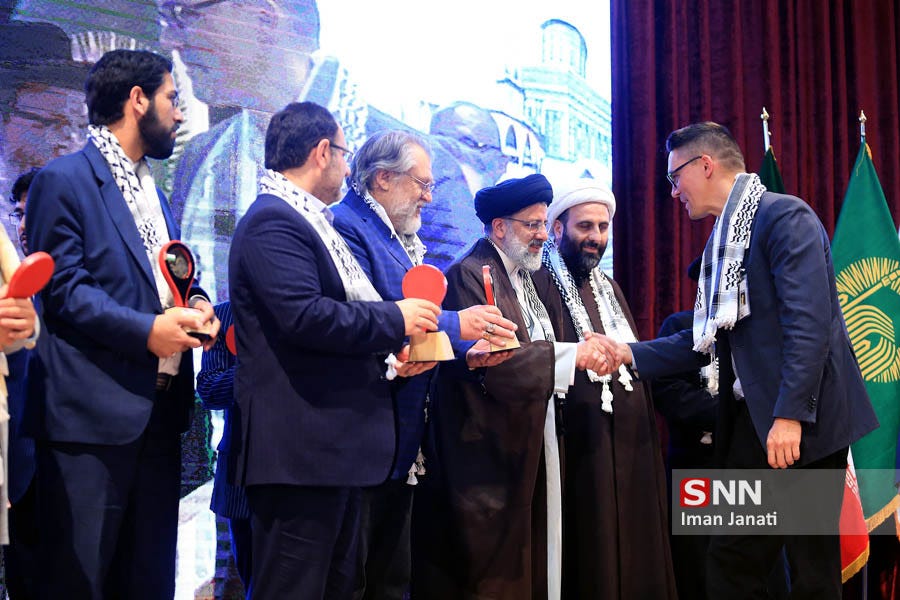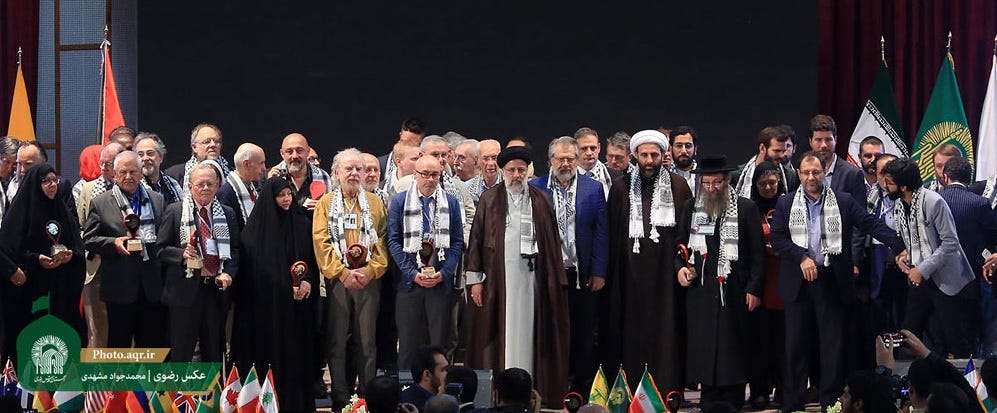
State Department whistleblower J. Michael Springmann and I discussed the Axis of Resistance’s defeat of Israel on the new False Flag Weekly News. Below is my new essay on a related topic, scheduled for translation and publication in Iran... -KB
Ibraham Raisi and the Politics of Martyrdom
By Kevin Barrett
On May 19, Iran lost one of its all-time greatest leaders—which is saying something, since that proud ancient nation has had plenty of leaders since it was first unified in 625 BC. President Ibrahim Raisi’s death in a helicopter crash shocked the world and evoked massive outpourings of mourning across the country. Millions of people poured into the streets of Tabriz, Qom, Jamkaran, Birjand, and Mashhad, and millions more followed the funeral demonstrations on social media.
President Raisi had assumed the presidency at a difficult time for Iran. He took office in June, 2021, almost a year and a half after the great general and likely future president, Qasem Soleimani, was martyred by a US military drone. Raisi’s predecessor, Hassan Rouhani, had devoted his presidency to fruitlessly striving to improve relations with the United States. Rouhani’s thanks was to have the JCPOA nuclear deal, the signature achievement of the Iran’s West-leaning reformist faction, rudely shredded by Donald Trump and the Netanyahu-loyalist faction of the American deep state, which subsequently murdered Gen. Soleimani under Zionist orders.
So by June 2021, the Iranian people understood that the USA is, as Putin puts it, “non-agreement-capable.” They elected President Raisi to put an end to the Rouhani era of pointless appeasement, and inaugurate a new era in which Iran would calmly but firmly stand up for its own interests, and for the interests of oppressed people in the region and across the world.
President Raisi did not disappoint. On the contrary, he wildly exceeded expectations. Under his leadership, Iran became a full member of the BRICS alliance and the Shanghai Cooperation Organization. By deepening ties with Russia, China, and other relatively independent world powers, Raisi’s Iran not only improved its economic prospects, but also strengthened its defenses.
While deepening Iranian integration into BRICS, President Raisi had the wisdom to seek improved relations with Iran’s Persian Gulf neighbors, including the often-problematic Saudi Arabia and Bahrain. By working with Russia and China to gradually wean the region from US hegemony, the Iranian president helped create a blueprint for regional peace “without America and Israel.” That project, while it remains a work in progress, is clearly en route to full realization.
The Raisi administration managed to improve ties with former adversaries even as it strengthened the so-called Axis of Resistance nations and groups. It accelerated military support and technology transfer to Iran’s allies in the region, including sending rapidly-advancing drone and missile technologies to Yemen’s Ansarallah movement, Iraq’s Katā’ib Hezbollah, and Lebanon’s Hezbollah, while increasing military support for Hamas and Islamic Jihad in occupied Palestine.
President Raisi’s two-pronged approach of healing Iran’s breach with the Gulf states while strengthening the Axis of Resistance might sound like a contradiction. After all, Bahrain and Saudi Arabia, and to lesser extent the other Gulf satrapies, feared the Axis of Resistance because they saw it as directed against them. That’s why Saudi Arabia launched its disastrous war on Yemen in 2015.
But President Raisi, with the strong support of Iran’s Supreme Leader Ayatollah Ali Khamenei, and the cooperation of Russia and China, successfully conveyed to the leaders of the Gulf countries that the Axis of Resistance was primarily focused on freeing the region from Zionist-American occupation, and that there would still be a place for those countries, and their leaders, in post-Zionist, post-American West Asia.
President Raisi’s efforts to bring the region together in the transition to a post-Zionist post-imperialist world were greatly strengthened after the successful Al-Aqsa Storm operation on October 7, 2023. The Zionist regime’s genocidal reaction to Hamas’s courageous defense of Palestine and its holy places has proven, once and for all, that Islamic Iran’s position has always been correct: The Zionists are evil, genocidal lunatics who have no future in West Asia. Iran’s championing of the Palestinian Resistance, which has always had broad support across the region, has won the fervent and near-unanimous (if sometimes clandestine) accolades of the whole Arab and Islamic worlds, as well as the Global South and the younger generation in the Global North. So the wise policies of President Raisi have played a key role in the way the events of the region have unfolded since October 7th 2023, contributing to Israel’s humiliation and to its substantial weakening militarily, economically, diplomatically, and in its public relations and soft power.
Internally, President Raisi faced down yet another US-Zionist color revolution attempt. The CIA, with its tentacles in NGOs, propaganda networks, and astroturfed faux-populist organizations, manipulated the death of Mahsa Amini, who collapsed and died in a courtroom for reasons definitely related to her underlying medical conditions, and allegedly to an altercation with police, to try to foment fractiousness in Iran. Amini’s death was all-too-convenient for the enemies of Iran, who used it to try to balkanize the Iranian public along the faultlines of ethnicity, gender, and religion.
The CIA’s color revolution recipe involved getting relatively small numbers of people into the streets to protest Amini’s death. Professional provocateurs would attack police and encourage others to do likewise. Concealed CIA snipers and gunmen then shot people, including random pedestrians blocks or miles away from the protests. Taking advantage of the chaos, the CIA’s media and social media assets would broadcast false stories about nonexistent “huge protests” (with no supporting evidence like pictures of crowds) along with false claims that the victims of Western mercenary shooters had been killed by police. The result was a media bubble, completely unrelated to reality, purveying the fantasy that some sort of massive uprising was happening in Iran and police were shooting down demonstrators.
Unlike the CIA’s Maidan Square color revolution coup in Ukraine in February 2014, which was created by exactly the same formula—including CIA snipings falsely attributed to security forces—the Mahsa Amini coup attempt fell flat. The Raisi Administration, backed by the Supreme Leader, helped enough of the public understand enough of the truth to stop the chaos from snowballing. Additionally, Iran’s central authorities insisted on a more relaxed approach to its traditional Islamic dress code, and strongly forbade any abusive behavior on the part of police. So the 2022 CIA coup plot against Iran became one of the agency’s many failures rather than one of its perhaps equally many successes.
The CIA’s failed coup attempt included a concerted attack on the Iranian economy. The centerpiece of that effort was currency manipulation of the kind that brought down the former Soviet Union, economic-miracle Japan, the Asian Tigers, and other “problems” for US empire. Sanctions and sabotage also played a role. President Raisi’s administration weathered the shocks imposed by that round of economic warfare, managed to stabilize and begin reducing the 40% inflation rate, and increased economic growth to around 4%.
President Raisi and his leadership team were able to maintain social and economic stability even while defying US-Zionist pressure, and unprecedented sanctions, by forging ahead with the Iranian nuclear program. Despite unrelenting pressure including Zionist murder sprees against scientists and reckless sabotage of nuclear installations, Iran has succeeded in becoming, for all intents and purposes, a nuclear threshhold state with a potentially lucrative and sustainable civilian nuclear sector. The Netanyahu-sponsored Trump Administration shredding of the JCPOA has blown up in the Americans’ and Zionists’ faces.
Given President Raisi’s many successes, and his status as leading candidate to one day succeed Iran’s Supreme Leader Ali Khamenei, it is understandable that many Iranians suspect a Zionist or Zio-American hand in his fatal helicopter crash. Though Iranian authorities did not find bullet holes or other overt signs of sabotage in the helicopter wreckage, it is well known that the Zionists and their American backers use “deniable” plane crashes as an assassination technique. John Perkins, author of Confessions of an Economic Hit Man, has described his personal acquaintance with CIA-related “asteroids” who arranged deniable plane crashes designed to kill heads of state. Since bombs or bullets are not necessary to bring down planes, as evidenced by the van-based directed energy weapon used to kill Senator Paul Wellstone and his wife, daughter, and campaign staff in 2002, the “absence of evidence” that Raisi’s foreign enemies were behind his death is not “evidence of absence.”
The timing of the crash was certainly suspicious. Raisi’s death on May 19 came just a little over a month after Iran’s unprecedented April 13 drone-and-rocket blitz against Israel—retaliation for the Zionists’ murderous and criminal attack on Iran’s embassy in Damascus. According to independent analyses, including Pepe Escobar’s alarming but unverified account of Russia shooting down an Israeli plane heading for Tehran to launch a high-altitude nuclear EMP burst, the Zionists wanted to respond to Iran’s April 13 attack with massive escalation, but were restrained by from doing so by the US. In such context, a deniable assassination of Iran’s president would be typical of the lying, sniveling, cowardly Israelis. If Iran’s leaders know or suspect that such was the case, they are holding that knowledge close to their vests—and preparing for the day when revenge will best be served cold.
Any great leader who champions resistance against the Zionist-driven US occupation of West Asia, and the accompanying Zionist genocide of Palestine, automatically risks his life. Like Gen. Qassem Soleimani, Iranian President Ibrahim Raisi knew that standing up for his country, and for the genocide victims in Palestine, might impact his life expectancy. But that didn’t stop him. God willing, he is now among the martyrs in the highest station of paradise.













Ibraham Raisi and the Politics of Martyrdom